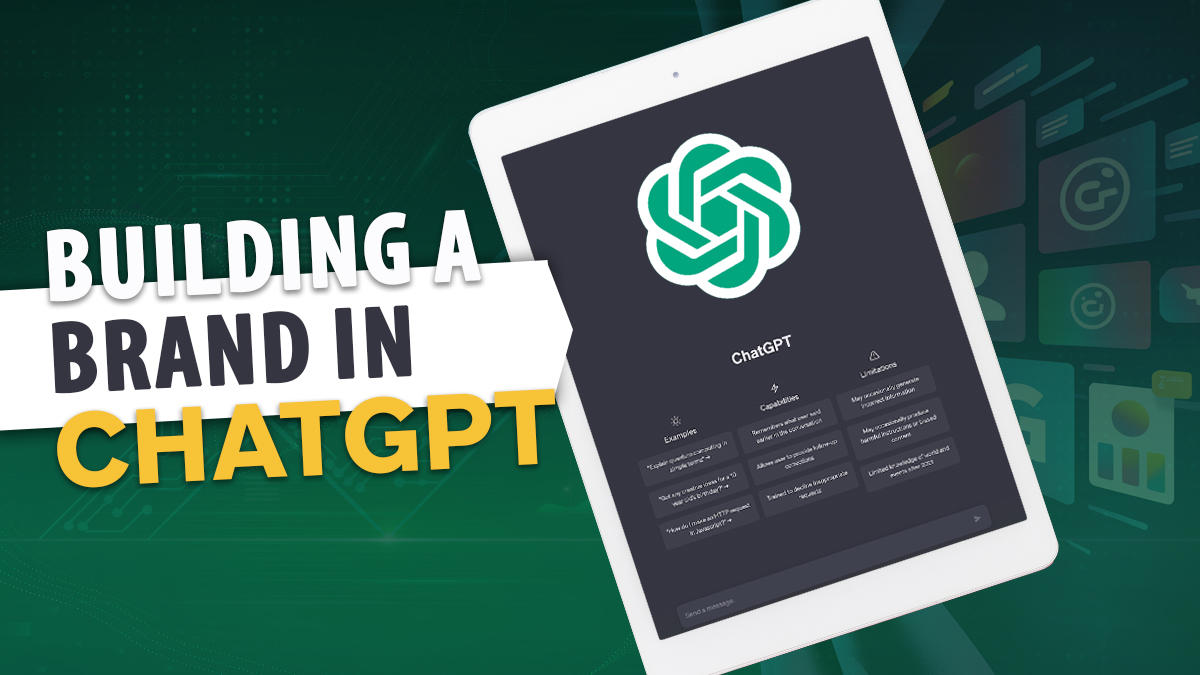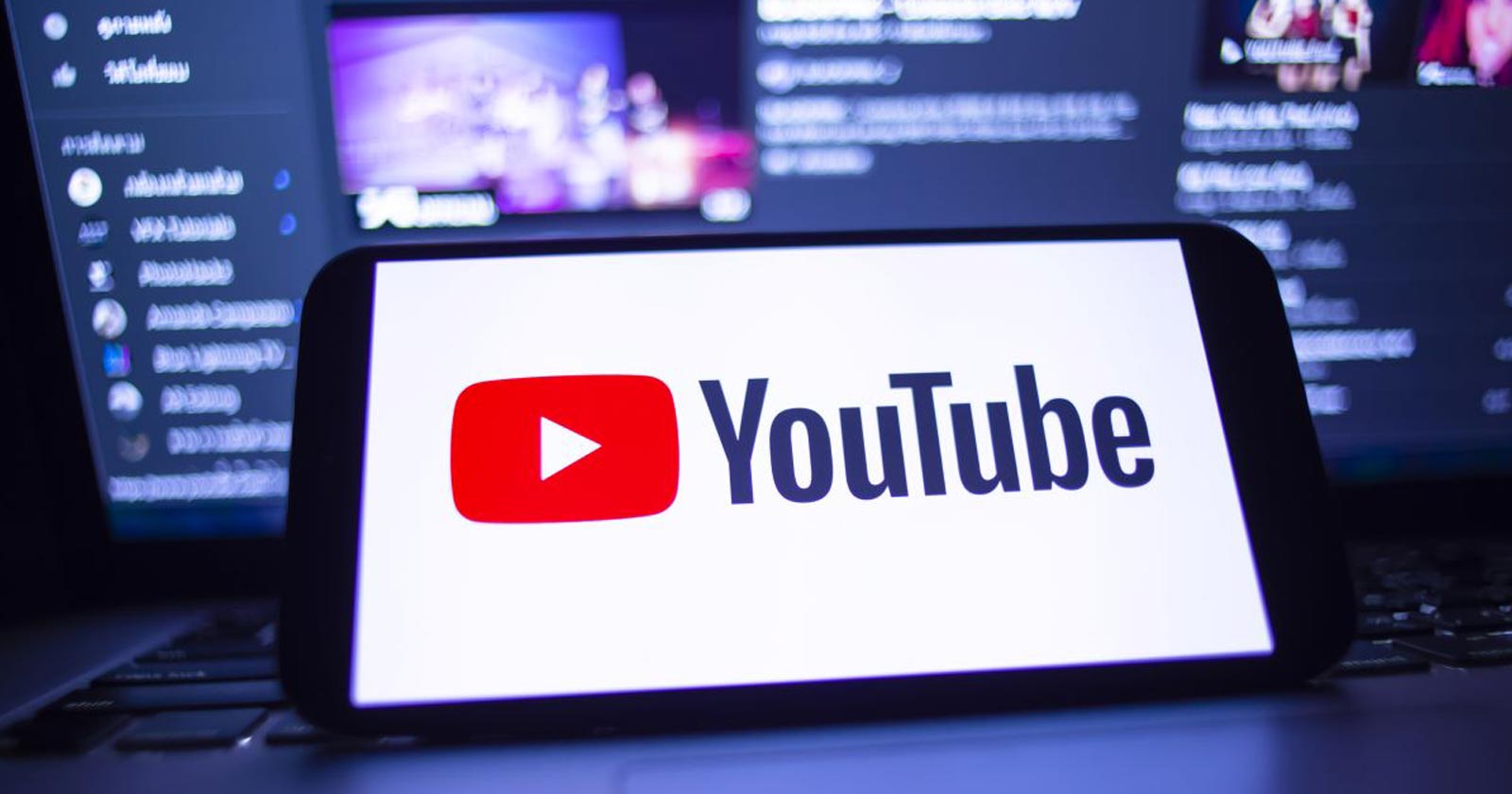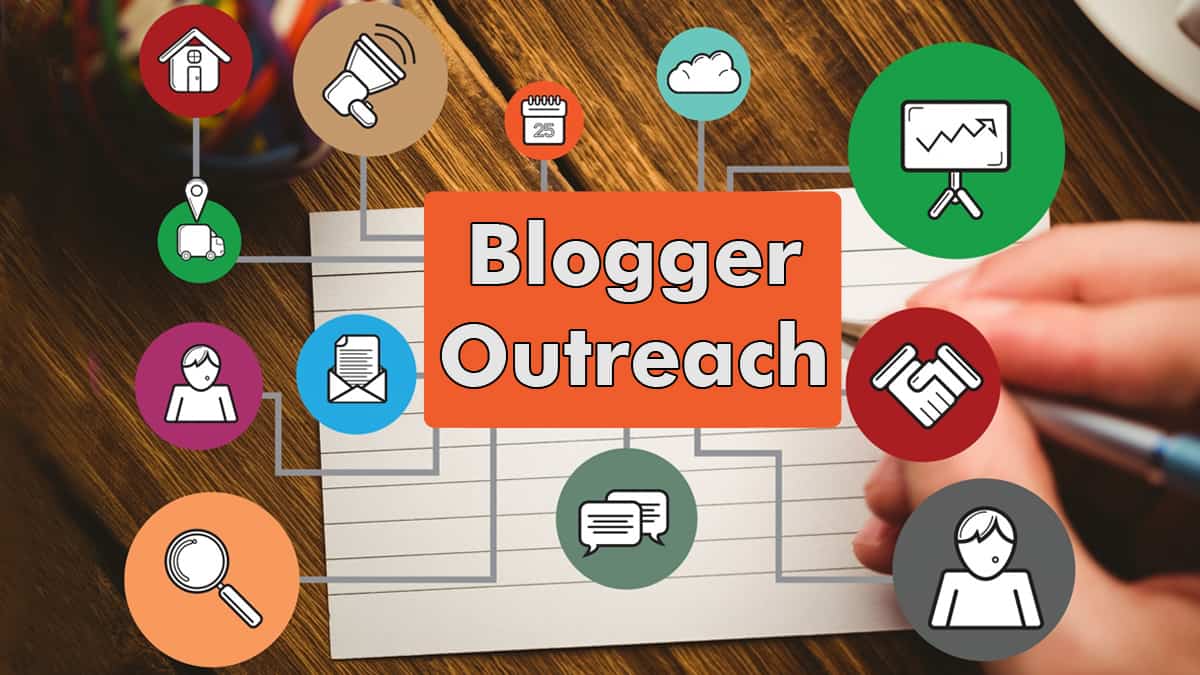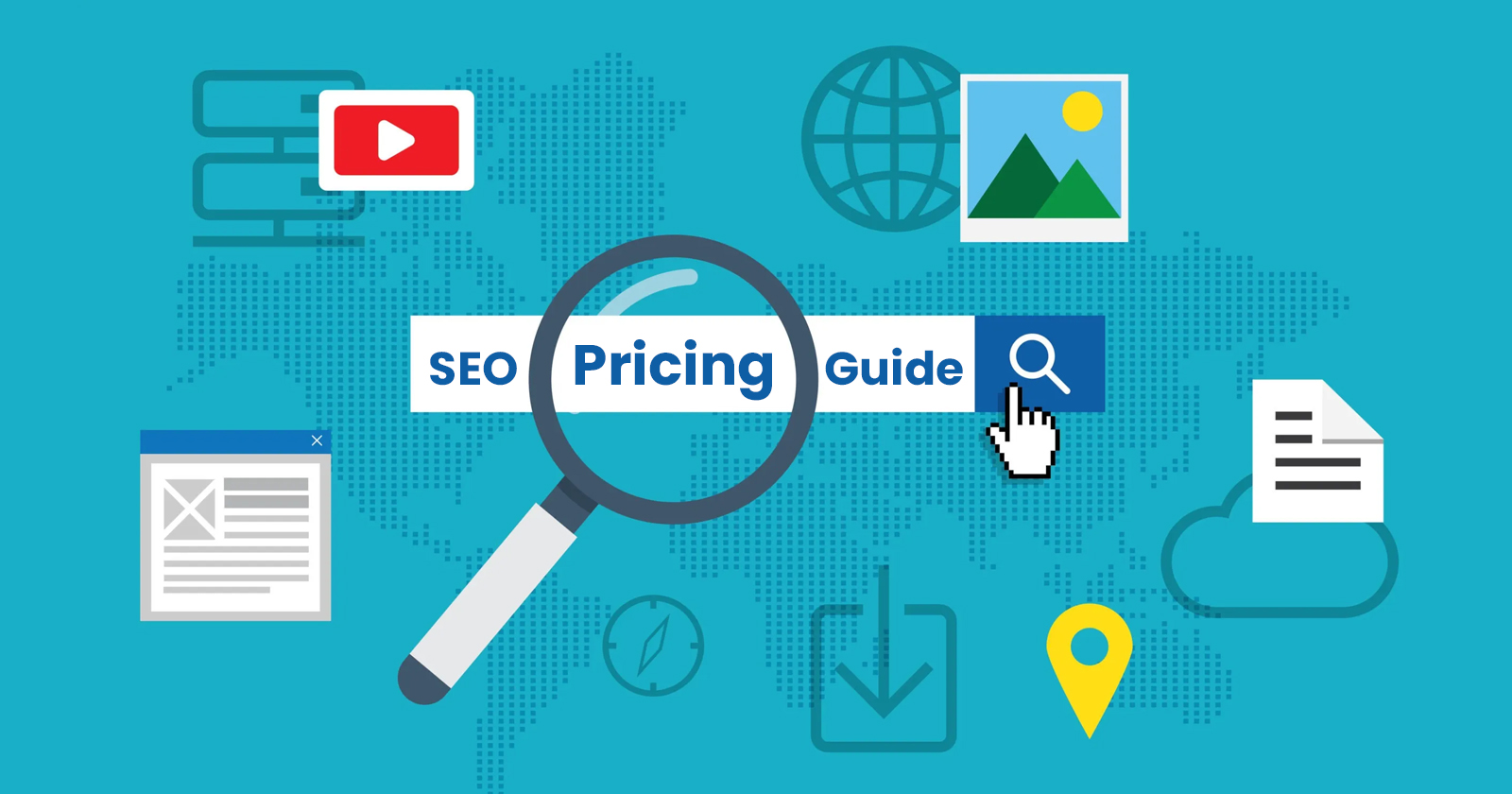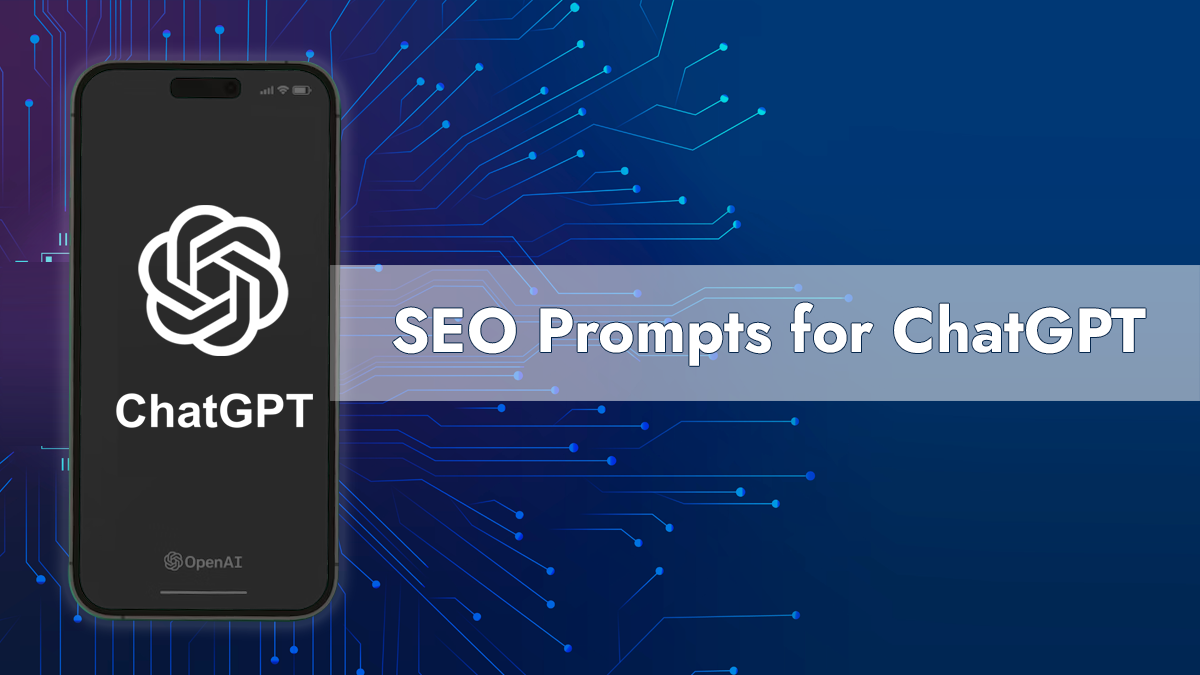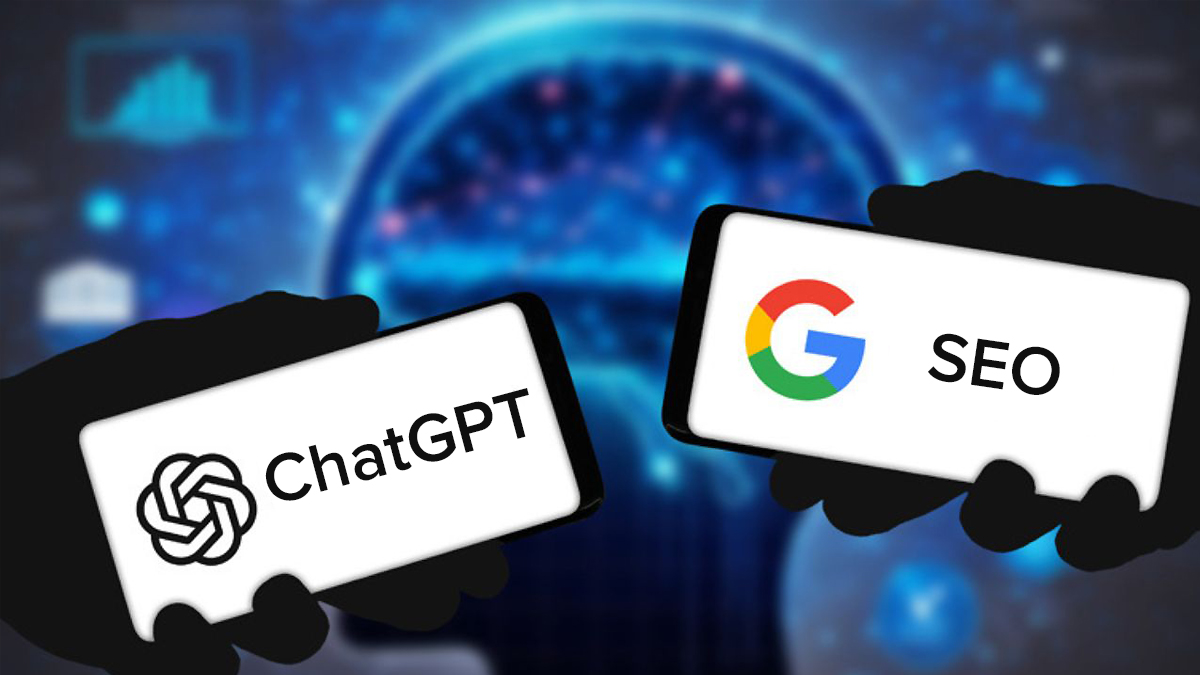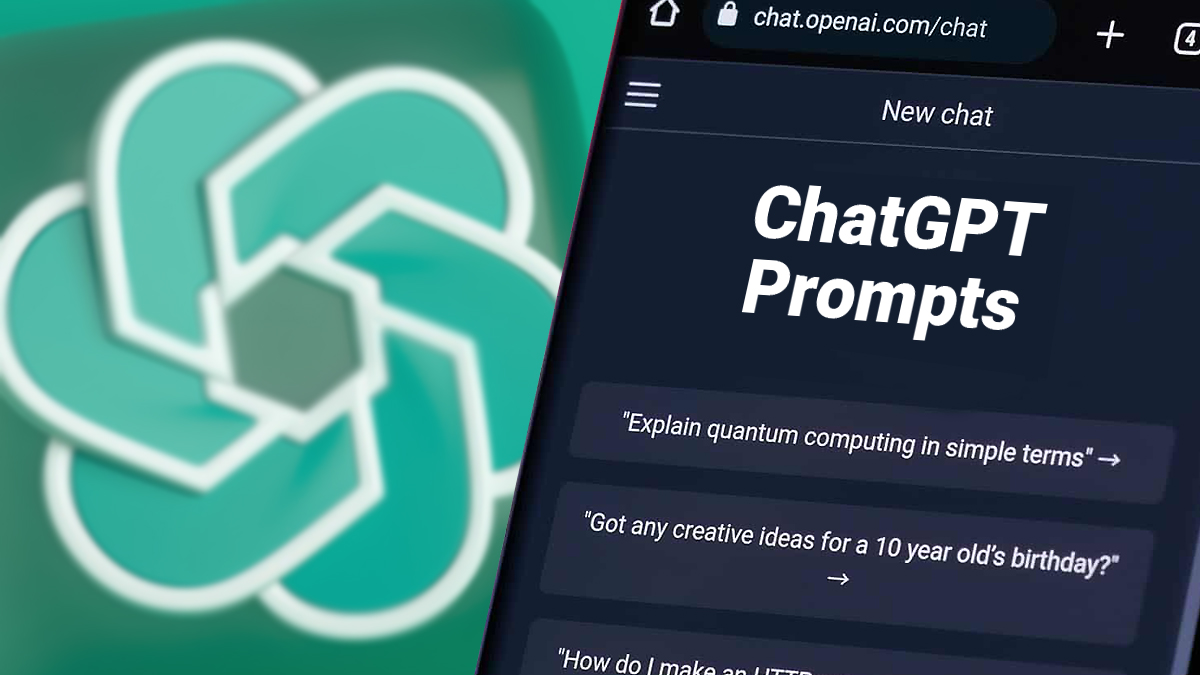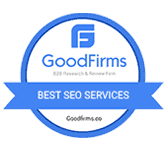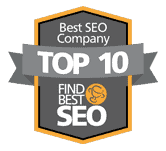Artificial intelligence isn’t something from the futureDiscover the hidden strategies and overlooked challenges of creating a powerful brand in ChatGPT. Learn what it takes to stand out with conversational AI. anymore; it’s a part of our everyday lives. It helps with things like making content, helping customers, automating tasks, and analyzing data.
As AI tools like ChatGPT, Notion AI, and Microsoft Copilot become important in how we work to build a brand in ChatGPT. Brands included in these tools are getting more notice and power than ever before.
Whether it’s a plugin, a source of data, or a suggested integration, being part of an AI tool’s network can enhance your brand, bring in new visitors, and help you stay relevant over time. But how can you achieve that?
Getting your brand noticed isn’t just about the right technology, it’s also about planning carefully, providing real benefits to users, and reaching out actively. In this post, we will show you how to make your brand easy to find and indispensable in the age of AI.
How AI Tools Get Information?
Search engines and AI chatbots are very different, even though both can help you look for information online. A search engine like Google uses a program called Googlebot to look through and organize websites on the internet that are related to certain keywords. It uses a complex formula with many ranking factors to decide the content’s:
- Quality
- Relevance
- Trustworthiness
- Accuracy
Web pages that are considered the best and most related to what a user is searching for are placed at the top of the list. A chatbot like ChatGPT works very differently. First, it doesn’t keep searching and organizing the web all the time.
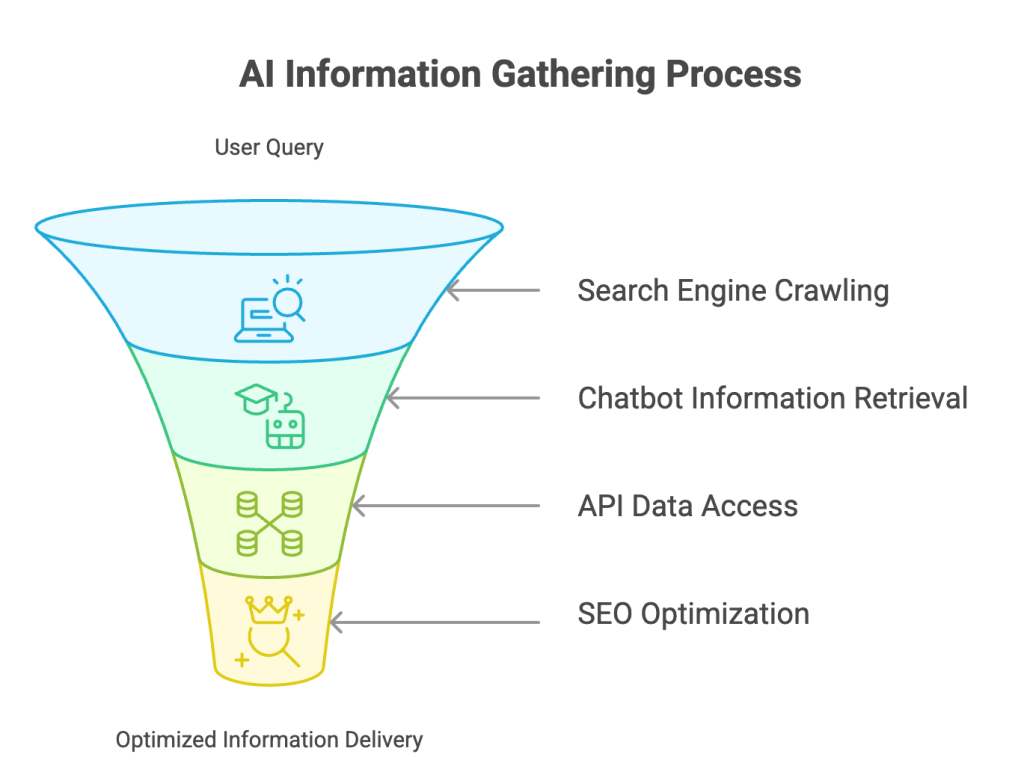
Instead, it looks for information online whenever a user asks for something that needs to be accurate and up-to-date. Sometimes, for general questions, ChatGPT uses the information it learned from a lot of materials like books, websites, and other sources. Whenever it looks for information online, it finds mentions and quotes about brands from:
- Reliable online news websites like Reuters, BBC, Associated Press, and The Guardian
- Online shopping websites like Amazon and Home Depot
- Forums like Reddit, Quora, and Stack Exchange
In simpler terms, AI tools usually rely on trusted websites that regularly update their information (being correct and up-to-date are very important). APIs are also important for how AI tools get information from the internet.
APIs help AI tools get data straight from a source instead of having to look for it on a website. That means a tool like ChatGPT doesn’t need to visit a website directly. It gets information through an API instead. For example, ChatGPT can use Google’s Search API to get current search results right away.
AI SEO agencies help get your brand into ChatGPT by optimizing your web presence with structured data, authoritative content, and semantic SEO strategies that make your brand more discoverable by AI language models.
Also Read: 100 Eye-Popping AI Statistics for Marketers in 2025
Landscape of AI Tools
Content and Design
Content and design AI tools are changing how companies and people make marketing materials, social media posts, and images. Websites like ChatGPT, Jasper, and Canva’s Magic Studio use AI to quickly create blog posts, sales emails, ads, infographics, videos, and other content, usually within minutes.
These tools are great for brands that want to create more content without needing a lot of people. If your brand provides templates, visual tools, helpful content, or specialized knowledge, being included in these tools can make you a trusted resource.
For instance, a marketing software platform could have ready-made templates right in Canva or work with ChatGPT to create a special chat program that uses its information. Knowing how content creation works with AI helps you position your brand as a useful boost for creativity and productivity.
Automation and Productivity
AI tools that help with productivity and automation make daily work easier in many fields, allowing users to finish tasks more quickly and efficiently. Tools like Zapier, Notion AI, and Microsoft Copilot use AI to make tasks easier.
They can summarize documents, automate emails, create meeting notes, schedule tasks, and analyze data. If your product can help or improve how a business works, it could be easily combined with other systems.
For example, a CRM or HR system can work with Zapier to automatically follow up with leads or help new employees get started using AI. Similarly, if your tool helps with focus, planning, or getting things done, AI platforms like Notion might showcase your brand as part of how they work.
Productivity AI works best when it connects easily with other tools and saves time. If your product fits these goals, you’re in a good spot. By knowing what workers need every day, you can focus on the AI tools they use and become a part of their favorite online platforms.
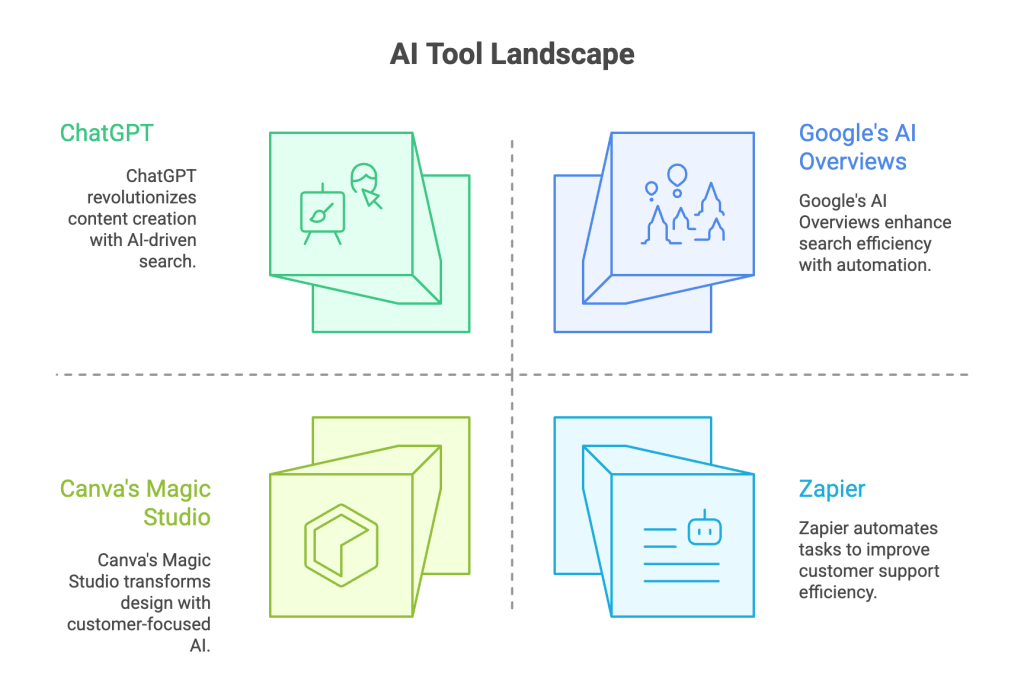
Customer Support and Sales
AI tools for customer support and sales help businesses respond faster, make interactions more personal, and increase sales. Platforms like Intercom, Drift, and HubSpot AI use chatbots to answer questions, schedule meetings, find potential customers, and help users through the sales process.
If your brand provides help with customer relationship management, online shopping, getting customer opinions, data analysis, or finding new customers, these tools are a good way to start.
For example, connecting your service with an AI chatbot can make it simpler for users to find your product while they get help, which leads to a smoother experience and more usage. AI-powered sales tools also focus on connecting with other systems to show useful information in one easy-to-read dashboard.
If your platform helps people make better decisions or communicate with clients, being included in these tools makes it more trustworthy and widely known. The customer journey is becoming more automated and based on data. Knowing how your brand fits into this is important for standing out in the growing AI industry.
Search and Discovery Engines
AI is changing the way people search for information on the internet. Tools like Bing AI, Google’s AI Overviews, and Perplexity AI can summarize information, answer questions, and help with decisions using everyday language.
They often get their information from a mix of websites, knowledge sources, and organized data. If your brand is well-known, has clear communication, and provides reliable data, it can show up in AI-generated summaries, even if you don’t directly connect with the AI.
For instance, a finance company that has articles in a question-and-answer format might be mentioned in AI search results as a reliable source. You can make your content easier to find by using schema markup, clear headings, and short answers.
Also, tools like Perplexity help prioritize trusted sources, giving brands a chance to be trusted references. Knowing how AI search engines organize and show results can help you create your content in a way that makes it easier for people to find it.
API Platforms and Integrations
For brands that focus on technology or data, API platforms and open AI systems provide easy ways to be included in AI processes. Platforms like OpenAI (with its plugins and APIs), Hugging Face, and GitHub Copilot extensions let developers and companies create and share tools, data models, or utilities that can be used in various AI applications.
This is especially important for software services, data analysis, education, and data companies. For example, a company that has its own weather information might provide an API on Hugging Face.
This would allow developers to create weather bots or tools for predicting the weather. These platforms appreciate openness, quality, and usefulness. This means that brands that offer good and well-explained APIs or datasets are more likely to be highlighted.
It’s a complicated but important way that often makes developers and businesses keep using it for a long time. If your brand has the right technical skills, working with these platforms can help you become recognized as an expert in AI.
Best Practices To Get Your Brand in ChatGPT
Creating APIs for your business can help you show your brand in ChatGPT answers and other AI tools. It’s what ChatGPT suggests you should do. If you can make a public API that search engines can find, you’re more likely to show up in more ChatGPT answers. If you decide to take this path, these tips will help make your brand’s API easy for AI to use:
- Using JSON-LD schema markup helps search engines and AI tools better understand your content. For example, online shopping sites should use product schema like price, reviews, and product details. On the other hand, websites with lots of content should use article schema like news articles or blog posts.
- Make sure your robots.txt file lets AI crawlers access your website. If you don’t do this, big AI platforms won’t find and use your API, making all your hard work for nothing. To improve things even more, you can upload your API instructions straight to OpenAI and Microsoft AI, which let you connect your API.
- Use a tool or add-on that allows AI tools to ask questions to your API. This means that a tool like ChatGPT can show reviews and current availability of your products in its answers.
However, using an API is just one way to increase how much people can see you in AI tools. You can and should try some other useful methods, so let’s take a look at a few.
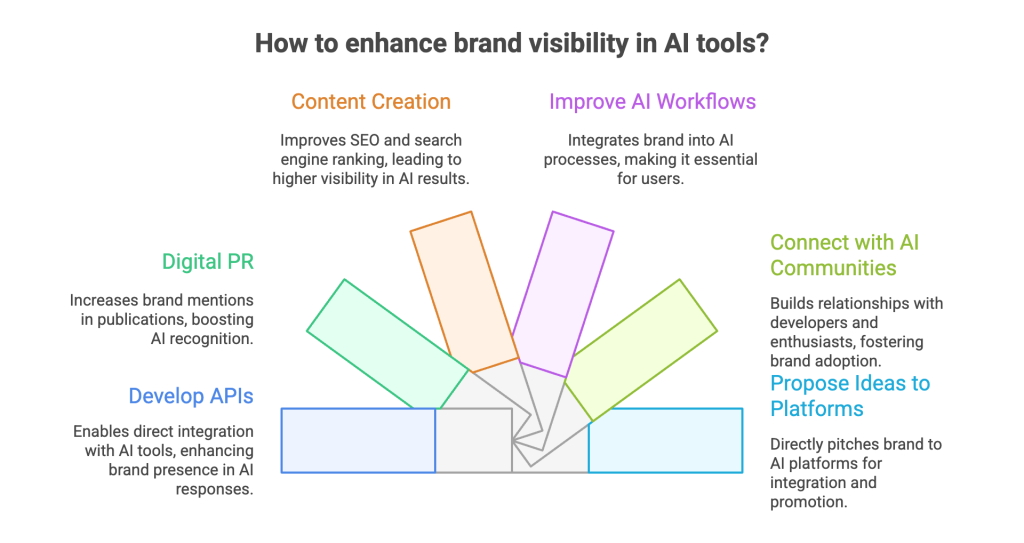
Use Digital PR to Get Mentioned in Well-Known Publications
If well-known publications in your field keep talking about your brand and suggesting your products, AI tools will notice. How do you get high-quality, specialized publications talking about your brand? You can do this by getting involved in digital PR.
This means connecting with online journalists, bloggers, and influencers to help more people know about the brand, get links from their articles, and drive more visitors to the website. Digital PR is about making your brand recognized as an expert in your field. This helps you get mentioned more by AI tools and boosts your SEO.
Make Great Content that Gets a Good Ranking
Another way to get noticed more on ChatGPT is to make good content regularly that shows up high on search engines. In other words, you need to make your SEO really great. You should work on becoming an expert in your area for your brand because it will help your visibility on search engines and in AI answers.
For example, making groups of related content will help search engines see that you know a lot about certain subjects. ChatGPT says that many AI tools get their information from popular websites, so making your SEO better is one of the best things you can do.
Help Improve AI Workflows
A great way to have your brand included in AI tools is to fit into how users work. AI tools are not just for doing things automatically; they are made to help users get results quicker and more intelligently.
If your product provides real benefits in the process, it clearly makes sense to include it. Begin by asking: How does my brand belong in the AI tool’s workflow? If you have a data analytics platform, you can provide useful information that AI tools can show right away.
If you run an online store, AI tools can use your list of products to help with searching or personalizing. Tools like ChatGPT, Jasper, or Notion AI suggest services that help you work better or give useful information, these are chances to improve.
You can also offer helpful tools like templates, data links, prompt libraries, or summary APIs. These resources help users make better use of AI tools and can also make you more noticeable in help documents, app lists, or examples of how to use the tools.
Another option is tools for developers. If your product helps developers make or launch AI features more quickly (like using software tools, automated scripts, or support services), it is more likely to be used by many people in AI projects.
Connect with AI Developers and Communities
If you want to be included in AI tools, it’s important to be seen where people talk about and work on these tools. This means you should connect with developers, researchers, and AI enthusiasts.
These groups often decide which tools, plugins, and datasets become popular, so it’s important to connect with them. Begin by helping with open-source projects on websites like GitHub or Hugging Face.
You can either make models, work with datasets, or help with AI tools there. This shows what you know and can lead to being mentioned in repositories, guides, and official tool integrations.
Join online groups and discussions like Reddit’s r/MachineLearning, AI Slack groups, Discord servers, and communities for products like Notion, Zapier, and OpenAI. Be helpful, share useful information, and honestly explain what your brand provides.
This creates a positive reputation and shows that you are a reliable person. Think about sponsoring or taking part in AI hackathons, conferences (like NeurIPS or Hugging Face Spaces), or programs that help AI startups grow.
People who make products and engineers from the tools you’re focusing on usually go to these events. A good partnership or demonstration can create real chances for collaboration.
Lastly, work together with AI influencers, teachers, and content creators who are already popular in the community. If they show how to use your tool in a tutorial or demo, more people will trust you and notice your product.
Propose Ideas to AI Platforms
Even if you have a great product and it offers good value, your brand won’t be noticed in AI tools unless the right people hear about it. That’s where smart pitching is important.
Most big AI platforms, like OpenAI, Zapier, Notion, Hugging Face, and Microsoft, have teams that work with partners, programs for developers, and ways to submit integrations and tools they want to showcase.
First, find out how the platform you want to use takes in contributions from others. Many have public lists or directories (like the OpenAI Plugin Store, Zapier App Directory, and Notion Integrations Gallery) where you can submit your tool or API.
Just submitting something isn’t enough, you have to be noticeable. Create a simple and strong message that explains what problem your product fixes, how it improves the user experience on the platform, and any special features or data you provide.
Add customer reviews, important numbers (like how many people engage with it, how many stick around, and return on investment), and pictures or demos that clearly show its value.
Think about how showcasing your brand can help both you and them grow or make their user experience better. Besides sending your work directly, connect with the people who make choices on the platform.
Contact developer advocates, project managers, or community managers on LinkedIn or at events. Suggest working together on things like webinars, guides, or sharing content. You can create excitement early on.
If you show that people are using your product, it’s getting talked about in the news, or developers are using it, it makes a stronger case for getting officially highlighted. Being active, professional, and in line with the platform’s goals boosts your chances of being highlighted.
Also Read: How to Rank in ChatGPT: SEO Strategies That Actually Work
How to Find Mentions on AI Tools?
How can you know if your AI optimization methods are effective? There are a few ways to keep track of when people mention you using AI tools. One way is to monitor when people talk about your brand online using tools like BuzzSumo, Ahrefs, and Semrush.
A tool like BuzzSumo will show you how many times people talk about your brand online and where they do it. You can set up alerts so that you get an email whenever someone talks about your brand or a specific word.
Ahrefs Alerts has features that are like Semrush’s Brand Monitoring app. These tools are good ways to track how your brand is doing online. The more times people talk about you, the higher the chance you will show up in tools like ChatGPT.
How can you check when people talk about you in ChatGPT? Sorry, but OpenAI and other companies don’t share this kind of user information right now. However, marketers have found clever ways to estimate how often people mention ChatGPT.
It works by creating a list of questions that your audience might ask, putting them in Google Sheets, and then using Apps Script to get answers from ChatGPT. This way, you can check if ChatGPT is talking about your brand when people ask important questions.
To Conclude
As AI tools change the way people look for information, create things, automate tasks, and communicate, brands have more chances to get noticed on these platforms quickly. To have clear visibility in AI tools, you need to plan carefully, have the right technology ready, and know how your brand can really help.
To get your product noticed, connect it with AI tools, involve developer groups, provide integrations or APIs, and make smart pitches. This way, your brand will be seen by users when they need it the most.
The important thing is to look beyond regular marketing and pay attention to usefulness, building trust, and making things easy to find in the world of AI. Brands that start using AI early and form real partnerships with AI platforms will have a lasting benefit in being noticed and having influence.
Begin getting ready now, and your brand won’t just join the AI discussion, it could help guide it. The tips in this post will not just help your brand get noticed, but also become a part of the future of work.
FAQs
What kinds of brands can gain from being included in AI tools?
Most brands can improve, especially those in technology, software services, online shopping, data, education, and content. If your product helps with being more productive, making decisions, being creative, automating tasks, or gaining insights, it fits well in the AI world. Even service-oriented businesses can help by providing plugins, data sets, or templates. The important thing is to make sure your service matches what AI tools are good at, like providing up-to-date information, or making complicated tasks easier.
How can I find out which AI tools are best for my brand?
First, find out what tools your customers are already using, like Notion, ChatGPT, Zapier, or Intercom. Next, think about how your product can fit into a normal process that uses AI. Is it for creating content, automating tasks, communicating, analyzing data, or helping with decisions? Also, check out AI marketplaces and integration lists to see where similar brands are listed. Try out the tools yourself and find ways your solution can improve their functions.
Do I need to be a tech company or have an API to get featured in AI tools?
Not required, but it’s useful. While many AI tools focus on connecting with other software through APIs or SDKs, there are other methods to get noticed. If your brand has a lot of information, AI search tools might refer to your resources. If you run a design company, your templates could be part of AI design tools. Having a simple and easy-to-use API, plugin, or tool can really help you get included in AI processes.
How can I grab the attention of the AI platform teams?
Create a careful plan to connect with people. First, find the right person to talk to, like product managers, partnership leaders, or developer advocates. Explain your idea clearly: what problem you are fixing, how your tool makes the AI platform better, and share any positive comments or experiences from users. You can get noticed by helping with open-source projects, joining their community chats, or participating in AI talks on LinkedIn, GitHub, or Twitter/X.
What part do developer communities have in getting featured?
Developer and AI communities are where people make decisions, find new ways to work together, and popular tools spread quickly. Being involved on sites like GitHub, Hugging Face, Stack Overflow, and Discord can help you gain trust, make connections, and get noticed early on. Running tutorials, sponsoring free tools, or making AI demonstrations that show what your brand can do can attract attention from both users and people who make decisions about the platform.
